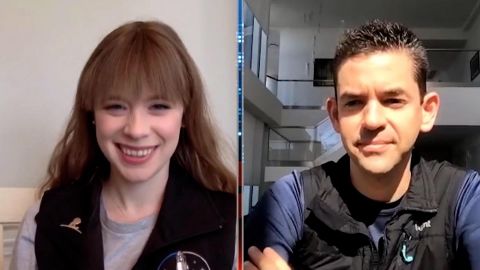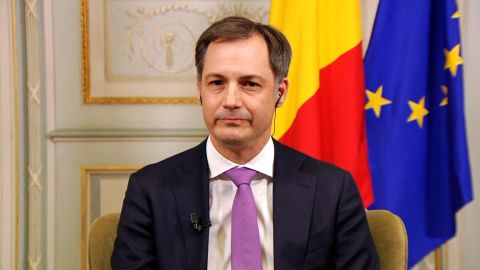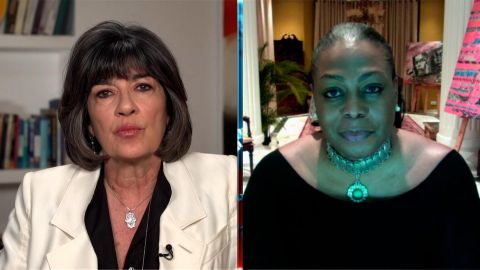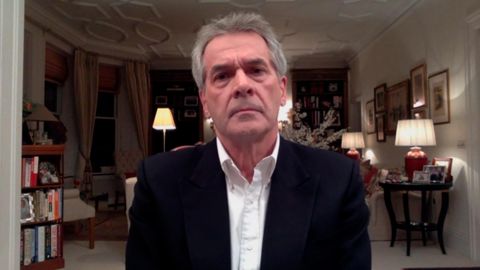Read Transcript EXPAND
CHRISTIANE AMANPOUR: And now, from the challenges here in on earth to a potential future written in the stars. Billionaire entrepreneur, Jared Isaacman is funding the world’s first all civilian space mission, that’s with SpaceX, and it’s call Inspiration4. He’s using the event to raise money for St. Jude Children’s Research Hospital, which fights cancer and other diseases. Hayley Arceneaux has been chosen as the first crew member on this the flight. She’s a 29-year-old cancer survivor and a physician assistant as St. Jude. They’re joining our Walter Isaacson to discuss why space travel should be open to all.
WALTER ISAACSON: Thank you, Christiane. And Jared and Haley, welcome to the show.
HAYLEY ARCENEAUX, INSPIRATION4 HOPE SEAT CREW MEMBER: Thanks for having us.
ISAACSON: So, Jared, tell me about this. Why did you decide to commission or to charter, in a way, to be the first all civilian mission into space?
JARED ISAACMAN, INSPIRATION4 COMMANDER: Well, I mean, I feel like at some point this was just going to be, you know, an eventuality that space was going to be opened up to everyday people. And, you know, you just don’t have to be, you know, lucky enough to be selected as a NASA astronaut. So, I’ve been kind of knocking on the door of the commercial space industry for 12 or 13 years saying, whenever this day comes, you know, please keep me in mind. And then just recently, like really only like three and a half months ago, I was on a call and reiterated my commitment to commercial exploration and they said it’s going to happen sooner than you think and it might even happen in like the next year. But I had no idea it would happen that fast and I had no idea we would have the opportunity to do the first all civilian mission to space.
ISAACSON: Well, you didn’t want to make this just a billionaire’s hobby or something. So, you reserved a couple of the seats for special purposes. Explain that, and we have Haley here, explain how you decided to pick Haley to be one of the seats?
ISAACMAN: Sure. So, first of all, I don’t think there’s anything wrong, you know, whether it’s a year from now or 10 years from now or 50 years from now, I hope like, you know, fishing buddies can go to space together. Like that’s what we’re trying to work towards is to make this like really accessible and affordable for everyone because the world is more interesting when people can go and dance among the stars and such. But Inspiration4 is the first. And the first is always significant and it comes with great responsibility. And that’s why we wanted to be incredibly thoughtful about, you know, the organization that stands to benefit, which is St. Jude’s Children’s Research Hospital, because they have absolutely nothing to do with space or rockets, but they do have an important mission right here on earth, which is fighting childhood cancer. And if we are going to have the right to go to go and exploring the worlds beyond ours, then we have a responsibility to take care of some of the significant problems that we have on earth, and that’s where St. Jude’s comes into it. And then the second component is, is that crew selection process. I wanted every single one of the crew members to be able to deliver a very powerful and inspiring message in their own right. And that’s where the mission pillars came up of leadership, hope, generosity and prosperity, because I believe everyone in the crew members that we’re going to bring on this mission and the process we went about to finding them will deliver a very powerful and inspiring story to a lot of people, many of which may never want to be astronauts, they’re going to space, but just believe that, you know, in the case of Haley, that you can run into really difficult challenges in life and face, you know, challenges and adversities and overcome them and still live out your dreams. And that may never be as an astronaut.
ISAACSON: Haley, I mean, that’s amazing and you have overcome a lot, you’re a cancer survivor, you’d be the youngest person ever to go into space and you’re involved with St. Jude’s. So, tell me, how did you decide to put your hand up? How were you chosen? And what do you hope you’re representing?
ARCENEAUX: Well, I was not part of the selection process. I hadn’t even heard about this mission. St. Jude called me in early January and they said they had something to talk to me about. And they told me about this mission and then they asked if I wanted to go to space, and immediately I said yes. It was a no-brainer. I mean, this is a once in a lifetime opportunity and it’s incredible for St. Jude with how much money that we are going to raise for this hospital and the research that’s going to come out of this and the awareness of the hospital. But I am just so excited to represent childhood cancer survivors everywhere. It is an incredible honor. And you know, I’m a P.A. at St. Jude’s now. I work with these kids every day. I know how hard they fight. And I think this is really good to give them something to look forward to.
ISAACSON: Well, St. Jude’s an absolutely wonderful place. And you, too, as you’ve said, were a cancer survivor. Tell me about that journey. You have a prosthetic limb. Tell me how — what you overcame and why this space flight might be so important.
ARCENEAUX: I was diagnosed with osteosarcoma, which is bone cancer, at age 10. And when I got that diagnosis I just fell apart. At age 10, everyone I had known with cancer had died and I thought this was a death sentence. And it wasn’t until I got to St. Jude a few days later that I felt hope immediately from when I walked in the doors. And I felt like I was going to be OK. And so, I spent a year there undergoing intensive chemo and then I had surgery that was actually able to save my leg. They replaced the bone that was affected by the tumor with a rod that could be expanded without surgery, because I was still growing at the time. And it just gave me so much quality of life. And I had such an incredible experience at St. Jude that all I ever wanted to do was to work there. And now, I have my dream job and it is incredible.
ISAACSON: Tell me about the kids that you are working at St. Jude and how they are reacting to this fact that you, a survivor, will be flying into space?
ARCENEAUX: I have to say they are so excited. And the first day I got back after the announcement, I was walking through the halls and I got stopped by a couple of different families, they were just so excited to get to talk to a survivor going to space. But one that really stood out was this mom and daughter came up to me, I had never met before, and they started to tell me about their journey and how much this meant to them and how it was giving them hope. And it really meant the whole world to me.
ISAACSON: So, tell me the process, Jared. What happens going forward now? How do you choose the rest of the crew? How do you train?
ISAACMAN: Sure. So — well, 50 percent of the crew is now identified. The Dragon spacecraft will go and fit four people, and that’s your mission pillars of leadership, hope, generosity and prosperity. So, Hayley represents our mission pillar of hope, and now we have the other two. And the mission pillar, generosity, is basically a — random selection is part of our fund-raising effort for St. Jude. So, from the beginning of February to the end of February, if you went to the mission website, you made a donation to a great cause, then you are in the running right now as a part of that random selection process. And we should know who that person is, like really soon, in the next couple of days. And then the final crew member seat which represents the mission spirit of prosperity, well, that was an entrepreneur selection process. And basically, a lot of people created an ecommerce website and then made a video about their business and they told the world about it on Twitter and basically shared their idea and why should be elevated to the stars. And then through an independent judging process, which is just wrapping up now through four independent judges, we’ll select our fourth and final crew member of Inspiration4, which represents that mission’s spirit of prosperity. And then we go right into training. So, from now on, really, until the launch.
ISAACSON: So, you are already a pilot or a trained, you know, pilot for airplanes. What will your training be like and do you worry a little bit that a — this is a first time like you’ve had a crew with no professional astronauts.
ISAACMAN: Well, that is for sure that today, it is a crew with no professional astronauts, but by the time we get to launch and the strap into Dragon, the F.A. said that we will be commercial astronauts. And the whole training program that NASA and SpaceX and the F.A. have come up with is exactly the journey we’re going to go on in just a couple of weeks from now.
ISAACSON: So, tell me exactly, what do they do to train you?
ISAACMAN: It’s a lot of simulator time. I mean, that’s the heart of it. So, there’s academics on the systems that we’re going to be operating and some orbital mechanics so that we know exactly what’s happening when we flip a switch or push a button. And then everything else is just repetition in the simulator of all the things that are supposed to go right and, you know, what are the procedures and events if certain things go wrong. And when we’re comfortable in the simulators, we’re also going to have a lot of time at the Kennedy Space Center where we’re going to be doing some zip lining off of Pad 39A, which is pad safety training. So, that sounds pretty exciting actually. And then we’re going to do some water survival training, some centrifuge training. So, we’ll be well-prepared before we ever strap into the spacecraft.
ISAACSON: I’ve heard Elon Musk and, of course, Jeff Bezos also talk about ending the government’s monopolization, it’s hold on space and space travel. Is this a good thing? Is this something you feel should be democratized?
ISAACMAN: Absolutely. I mean, right now, you have a better chance of getting struck by lightning than becoming a NASA astronaut. And I think the world is like very interesting out in space and it should be available and accessible to everyone. You know, the FAA, for example, does not build the aircraft. The FAA does not fly people from one city to the next. You know, the FAA, a government agency, is a regulatory, you know, organization. It’s designed to certify and regulate and develop procedures for, say, you know, commercial flight in the United States and around the world. I think that, you know, NASA, in all that they have accumulated in terms of their knowledge and expertise on the space exploration will wind up, you know, being in a very similar role where they’re going to make sure that organizations like SpaceX and Boeing and many of the other commercial, you know, space exploration businesses to follow are adhering to the best standards of safety and such, but it will be commercial industry that’s going to open up and make space accessible to everyone. I don’t think it will be the government in the long run.
ISAACSON: So, Hayley, tell me about what your training is going to be, when does it start? Is there anything special that you’re going to have to do given the fact that you’re young and a cancer survivor?
ARCENEAUX: So, we’ll all be starting space training at the end of this month as a crew. We will have some additional training on top of that because I’ll be the medical officer of this flight. My background as a physician assistant, I was chosen to be the medical officer. And so, we’ll just get a little bit of extra training because of that.
ISAACSON: And is this something, you know, that you’ve always had in the back of your mind going up, that you’d love to be an astronaut?
ARCENEAUX: Well, I visited NASA actually a few months before I was diagnosed with cancer and I went to the — in Houston and back to see where the astronauts trained. And after seeing that, of course, I wanted to be an astronaut. I think all kids and adults that see that want to be astronauts. But then a few months later, I was diagnosed with cancer and my whole world changed and all I ever wanted to do since then is work at St. Jude. But also, really until this mission would not have been possible for me to go to space. I’ve got, you know, artificial body part. And, you know, until now, you’ve really had to be physical perfect. But this mission is changing things in a really powerful way.
ISAACSON: A lot of us remember the Challenger explosion in 1986 with Christa McAuliffe, a civilian, a teacher, a board. What are you doing about the safety? How are you assuring yourself and going to the process that this is as safe as it could be?
ISAACMAN: Well, I think it’s in two parts. And one of it is, is in my control and the other is the — you know, the very capable hands of SpaceX. So, you know, SpaceX has built a fantastic rocket with amazing technology. We’ve all been wowed by it, seeing their rockets, you know, come back to earth and land on spaceships. When you human rate a rocket, and let’s keep in mind, there is only one, you know, human rated rocket in the United States right now and it’s SpaceX’s. But there’s a lot of other companies making rockets right now. So, what does that mean? It means SpaceX had to, you know, go through a very lengthy certification process with NASA who draws on 60 years of lessons learned to say that the Falcon 9 system is very safe and reliable system to take human beings into orbit. And if you look at the track record of Falcon 9, its performance is better than any other, you know, rocket system, let alone a reusable one, you know, in the history of space travel. So, it’s starts, you know, with a lot of confidence and some great technology. And then second, I think it comes down to training, too, and taking this whole thing very seriously. And I really said that from the start is that, you know, we do believe in a world where, you know, families are living on lunar and Martian colonies at some point in time and everyone is jumping in their X wings and we’re living this very cool “Star War,” “Star Trek” life. Well, we got to start somewhere. And getting it right to where we choose to start is so important to make sure everything else that we want to happen follows. So, we’re going to take it really seriously on training to make sure we’re well-prepared.
ISAACSON: Hayley, it takes a bit of courage to do this, just like it takes a lot of courage to face childhood cancer. You know, what message are you sending about the fact, yes, this isn’t totally safe, nothing in life is, we have to have some courage if we’re going to pursue our dreams.
ARCENEAUX: Absolutely. And I do think that my journey with childhood cancer made me tough. It definitely made me who I am. And, you know, with everything in life, there are risks, and I feel fully confident in this mission but also, I just really hope to show people just embrace life. You know, when opportunities come your way, especially that excite you and that can challenge you, go for it. And that’s why I had no hesitation when I said yes.
ISAACSON: OK. Jared, tell me exactly how the mission is going to proceed. How do you blast off? What do you do? What happens?
ISAACMAN: Sure. So, there’s a lot of work from now until we get to that date where we strap into Dragon. So, it’s all the training, things we talked about before. But then there’s additional things too like payload and experiments. Our entire day up there will be pretty well scheduled from the time that you wake up and all the experiments that you are doing along the way until you go back to sleep again. So, we have the figure out — because there’s a lot of demand for payload and experiments right now, it costs an awful lot of money to put things in orbit and get the results from it. So, right now, we’re going through that kind of a selection process, too. But once we get ready and the training is complete and payload is finally selected and we’re trained on all the experiments we tend to do, well, then we’re going to launch into lower orbit. And this is going to be a very cool process and it’s going to go onto Falcon 9 rocket, which is a two-stage rocket’s orbit. And when we get to orbit, we’re going to be going 17,500 miles an hour. And we’re going — it’s going to be a rather interesting orbit, too. And, you know, up — for the last really 20 years, everything has kind of been direct to the space station. But we’re not going to the space station. So, we’re going to get some — a little bit of additional freedom to go out and, you know, kind of — you know, I would say make some symbolic moves, a little bit farther out from space station to signify where everything is going to going next, which is, you know, to new worlds ideally, back to the moon, Mars and beyond. And we’ll spend a couple of days in orbit and then we come back and re-enter the earth’s atmosphere, and we splashdown in the water and we have our big splash down party, probably somewhere near Florida.
ISAACSON: Great. And tell me about those experiments that take us to the next world and beyond. Give me an example.
ISAACMAN: Sure. So, one of them actually relates to the impact of radiation on cells. So, there is radiation in space. You don’t have the same protections of an atmosphere. And we know an awful lot about the impacts of the radiation on the human body at the international space station, because we’ve literally just literally been there for 20 years and there’s more modern technologically advanced world where we can measure this type of things. Now, we’re going to go out a little bit farther than that, and the radiation level, which will be very safe for sure, it will be different than what’s been studied for the last two decades. And it’s important to get data on this because if we are going to journey out again and go back to the moon or Mars and beyond, like we’re going to have to know the impacts of whether there’s a long duration element it to, but also the radiation exposure that comes from being in space and the impact it has on human physiology. So, that will be one component of the experiments that we’re pretty sure is going to be play a role in this mission.
ISAACSON: And what about you, Hayley, what are the scientific mission, the medical missions that excite you?
ARCENEAUX: Well, I think we’re all going to be working on the same projects together. But what I’m actually looking forward to the most while we are in space is we’re figuring out how we’re going to video chat with the St. Jude patients. And you know, kids are so visual, and I think actually getting to show them what their future can look like is going to be so impactful and they’re going to have so much fun with it.
ISAACSON: That’s an amazing journey you talked about, about having dreamed, you know, when you were 10 years old, and going down and watching space launch and stuff like that, and then realizing that you could not be an astronaut, because you’ve just got cancer. And now, it is all turned around. Tell me, how are you processing this?
ARCENEAUX: I think that I have been processing it slowly. This call came completely out of nowhere and I could have never guessed that this is something that St. Jude was going to offer and this will be part of my future, but it’s becoming more and more real each time I go to SpaceX. The last time Jared and I were there, we actually got to put on astronaut suits. And it was amazing. But, you know, I think that’s part of the beauty of life is you don’t know what’s around the corner and there can be some really beautiful things that come your way that you never expected. And so, just — I’m along for this ride and I couldn’t be more excited.
ISAACSON: Wow, Hayley and Jared, so amazing, so cool and thank you so much for joining us.
ISAACMAN: Thank you. Thanks for having us.
ARCENEAUX: Yes, we appreciate your time. Thank you so much.
About This Episode EXPAND
Peter Westmacott; Bonnie Greer; Alexander De Croo; Ayoade Alakija; Jared Isaacman; Hayley Arceneaux
LEARN MORE




